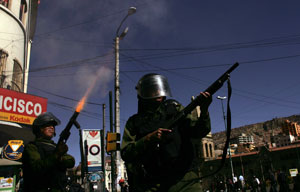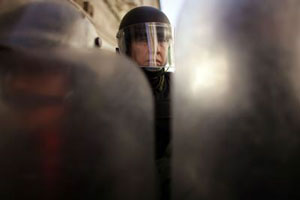A large tree branch was hauled out and placed in front of the police manning the barricades. It was doused with gasoline and promptly set alight. The cobblestone streets became thick with black, acrid smoke, giving brief respite from the tremendous Bolivian sun. Demonstrators, some dressed in colorful Indian attire, became increasingly enraged, chanting "down with Mesa" and inching ever closer to the red demarcation line. Wearing gas masks and helmets, the police stood solid behind their armor; they had been through this before and would refuse to let the disturbance spread past them and to the government buildings behind. A man in the crowd threw a large brown stick towards the police. It landed somewhere to my right; instinctively I knew what it was and along with the police lunged towards an alcove. The dynamite exploded and the streets of La Paz echoed with thunder. As the demonstrators sprinted down the street, volleys of tear gas slowly enveloped them, turning the streets into a sea of white toxic mist. Bolivia was once again falling into the nadir of chaos and violence, a place where it had been before and where it always returns.
 |
LA PAZ, BOLIVIA - JUNE 2: Police fire tear gas canisters towards protesters on June 2, 2005 in La Paz, Bolivia. Demonstrators from around the country have converged on La Paz to demand the resignation of President Carlos Mesa and to force the government to nationalize Bolivia's gas reserves. Spencer Platt/Getty Images |
Bolivia, South America's poorest country, is a land of contrasts and extremes. Geographically it is one of the world's most dramatic locales, set both in the high-altitude deserts of the Andes and the steamy rainforests of the Amazon basin. Its 8.5 million people are composed of a mixture of Andean Indians, who make up some three-fifths of the population and a light-skinned minority of European ancestry who generally control most of Bolivia's wealth. As a result, Bolivia has experienced almost perpetual unrest since it became an independent republic in 1825. Between 1825 and 1982 the country witnessed 188 coup d'états, a statistic that won the country a place in the Guinness Book of Records.
As a photographer, I had never covered Central America before. Since the events of September 11, the focus of the international news media had shifted, leaving continents with no visible nexus to international terrorism generally ignored. While Bolivia, and her surrounding neighbors, experienced coups, financial collapse and radical changes in leaders, the rest of the world passively shrugged. After seeing a photograph in a newspaper of the 2002 Bolivian unrest, I swore that I would someday make it there.
 |
LA PAZ, BOLIVIA - MAY 31: Demonstrators light fires in the street during outbreaks of violence between the police and anti-government protesters on May 31, 2005 in La Paz, Bolivia. Thousands of demonstrators have converged on La Paz to demand the resignation of President Carlos Mesa and to force the government to nationalize Bolivia's gas reserves. Spencer Platt/Getty Images |
The current crisis is predicated on the same issues that have plagued the country for years: a constituent assembly to rewrite the constitution and, most importantly, the nationalization of Bolivia's oil and gas sector, one of the largest in South America. Protesters, mostly from El Alto, a slum city of 600,000 that sits high above the capital La Paz, have perfected the art of dissent with their ability to shut the capital down on a whim. Using roadblocks and mass protests, the miners, peasants and workers have managed to shut down businesses, traffic, schools and hospitals. After some concessions to the protesters, Bolivia has temporarily moved back from the brink by the resignation of President Carlos Mesa. But the issues of concern have yet to be resolved and will surely be revisited on a later day.
On one of my last evenings in Bolivia I took a stroll with my fixer Jaz, ostensibly to look for some coca leaves, a legal product in Bolivia that tends to ward off hunger and thirst. We had come across a collective where a group of miners who were participating in the demonstrations had set up camp. Walking in we ascended a set of dark stairs that led to a locked gate. Jaz explained in Spanish who we were and that we would like to hear some of the miners' stories and take pictures. After some confusion and reluctance, we were led into a series of small rooms that had formerly housed a school. Mattresses and bodies were scattered everywhere and while it was nearly 11 p.m., the miners would not turn off the lights until 12 in case they were needed for an evening "action."
 |
Police stand guard outside of congress to keep back demonstrators on June 1, 2005 in La Paz, Bolivia. Thousands of demonstrators have converged on La Paz to demand the resignation of President Carlos Mesa and to force the government to nationalize Bolivia's gas reserves. Spencer Platt/Getty Images |
In a corner, set off from the group of younger miners watching a tiny black-and-white television, I came across a woman and her elderly husband. They had been in La Paz for some months, sleeping on a stacked set of dirty mattresses and trying to keep some order to their corner of the chaotic room. Leonarda Valencia Jujra explained that her husband Rene Jujra Mamanihad lost both of his legs in a mining accident. He lifted up his pants to display two worn prosthetic legs. Leonarda said that the government had never paid the small worker disability compensation he was entitled to. While documents and newspaper clips about the accident were displayed for us, Leonarda said that if they did not get the promised compensation she would strap dynamite to her body and blow herself up. As Jaz translated this to me twice for the sake of clarity, I glanced up at Leonarda and realized that she would not hesitate to follow through on this threat.
After leaving the cooperative and walking back up the street back towards my hotel, we stopped at a traditional Cholita woman selling snacks and sundry items at her street-side stall. Jaz inquired about coca leaves and she pointed to her friend's stall across the street. We crossed Santa Cruz Street, with its pizza restaurants, CD hawkers and zealous ice cream dealers and to the woman with the coca leaves. After producing a bag and weighing it on an old scale, Jaz was given the leaves and we left. Walking back home while chewing on the leaves we heard the last blasts of fireworks and dynamite echoing somewhere behind us in the night. The miners could safely go to sleep now as another day has come to a close in La Paz.
Spencer Platt is from Westport, Connecticut. After graduating from Clark University in 1994 with a degree in English, he commenced a career in photojournalism with an internship at the Troy Daily News. Spencer worked at numerous newspapers on the East Coast before joining Getty Images in 2000 as a staff photographer. Besides many domestic stories, Spencer has covered such international assignments as Iraq, Liberia, the Congo, Albania and most recently the tsunami in Southeast Asia. Spencer lives in Brooklyn, New York.






